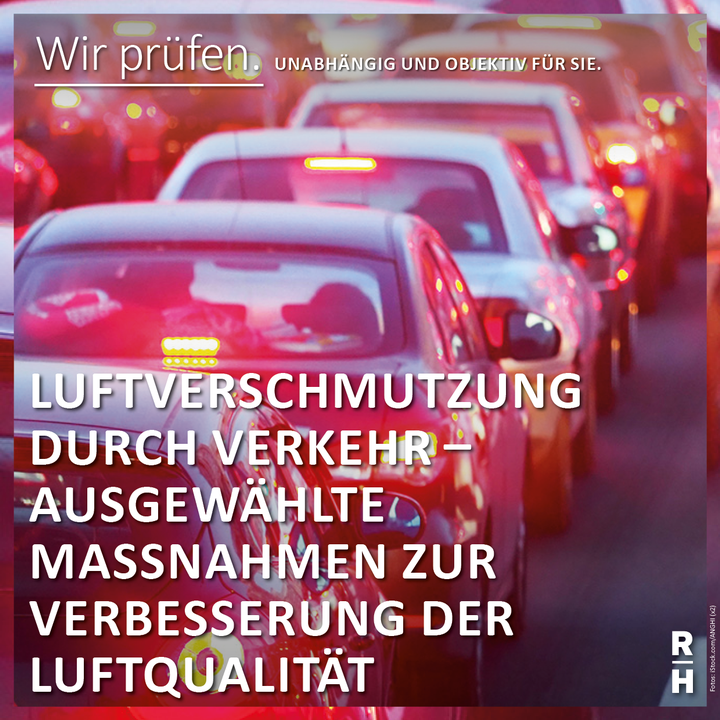Need for swift action against traffic-borne air pollution in Graz

The city of Graz (Styria) lacks sufficient measures against the principal cause of air pollution: motorized individual transport. This is revealed by the report published by the Austrian Court of Audit (ACA) today on "Traffic-Borne Air Pollution – Selected Measures to Improve Air Quality". The audit focused on Styria, namely on the period from 2014 through 2019. The implications of the lockdowns could not be taken into account during this audit.
The ACA considers that further measures are necessary to improve the air quality: public transport should be expanded and the motorized individual transport reduced. Among others, permanent speed limits should also be taken into consideration – 100 kilometres per hour on motorways and 80 kilometres per hour on federal highways and roads maintained by the provinces – in particularly affected regions in Styria.
The air quality in Styria has not improved since 2014
Road transport is a principal emitter of air pollutants. Although emissions of nitrogen dioxides caused by truck traffic have decreased by about 70 per cent since 2005, the emissions caused by cars have remained at the same level. Diesel cars in particular emit nitrogen dioxides to an extent that markedly exceeds the limit values.
Despite the fact that the level of particulate pollution has improved in the past years in Austria, it remained only slightly below the limit value at many measuring points. In Styria, no improvement of the air quality has been measured since 2014. High concentrations of pollutants that exceed the limit values both as regards nitrogen dioxide as well as particulate matter were registered at the measuring point “Graz-Don Bosco”. In many areas of the city, comparative measurements showed even higher values. In addition, Graz is, in percentage terms, one of the fastest growing conurbations in Austria. Between 2002 and 2015, the number of Graz’ inhabitants increased by some 41,300. Also the number of inward and outward commuters is continuously increasing.
In Styria, the “Greater Graz Area” and the “extra-Alpine region of Styria” are considered to be areas in which the limit values for particulate matter have been exceeded. As regards nitrogen dioxides, this concerns also the “Greater Graz Area” as well as the motorway sections of the “A 2 Süd Autobahn” and the “A 9 Pyhrn Autobahn”.
Effective measures have not been taken in the Greater Graz Area
In 2014, the province of Styria established the Air Pollution Control Programme ("Luftreinhalteprogramm 2014"). However, the very transport-specific measures that would have effectively reduced the air pollutants have not been taken: this concerns, for example, the driving restrictions for motorized private transport in the Greater Graz Area. Suggestions were made regarding a mandatory car-free day or the introduction of a city toll.
In accordance with the Air Pollution Control Programme 2014, flexible and permanent speed limits were introduced, but the general tempo limit of 100 kilometres per hour was applicable only for an about four-kilometres-long section of the “A 2 Süd Autobahn”.
Limitation of motorized individual private transport
The ACA recommends to the province of Styria and the Federal Ministry for Mobility to assess the introduction of permanent speed limits. In the spirit of improving the air quality and the health protection of the population, the most effective measures will have to be taken. In particular, driving restrictions for motorized individual transport in the Greater Graz Area should be reconsidered. The restrictions would also reduce the CO₂ emissions and make a valuable contribution to attaining the climate objectives.
The ACA also recalls the Sustainable Development Goals (SDGs), which address the topic of air pollution several times. Austria committed itself to implementing the SDGs by 2030. The ACA cooperates with the United Nations and reviews the national implementation of the SDGs.
Furthermore, the expansion of the public transport system is to be pursued vigorously to compensate for the restrictions on motorized individual transport. In accordance with the Air Pollution Control Programme 2014, tramway routes should to be massively expanded in Graz. From 2014 to 2018, however, only a small portion was implemented.
Infringement proceeding
The ACA furthermore critically highlights that, pursuant to the Ambient Air Quality Directive, infringement proceedings were initiated against Austria due to the fact that the value limits for particulate matter and nitrogen dioxides had been exceeded for a long time. Proceedings are still ongoing in connection with excessively high nitrogen dioxide levels. In case of a conviction, this can lead to considerable financial burdens for the affected local authorities.
- pdf Datei:
- 9,590.4 KB
- Umfang:
- 124 Seiten
Report: Traffic-Borne Air Pollution – Selected Measures to Improve Air Quality (in German)
From April to June 2019, the ACA carried out an audit at the Federal Ministry of Sustainability and Tourism, the Federal Ministry for Transport, Innovation and Technology, the province of Styria and the city of Graz on the topic of traffic-borne air pollution.
The audit aimed at assessing the framework conditions and the competences with regard to air quality and its development, as well as at evaluating the measures to improve the air quality in Styria. The audited period spanned the years from 2014 through 2019.


